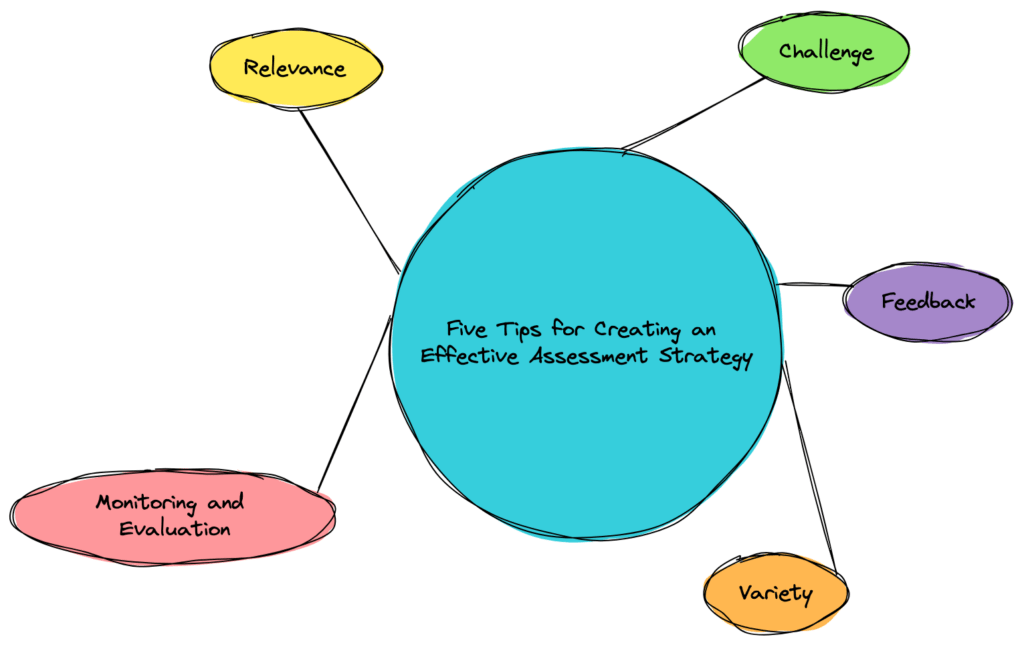An essential aspect of OfSTED’s Quality of Education judgement is the appropriate use of course assessments. Assessments should be relevant, support the development of knowledge and skills, and not overburden teachers and trainers. This article offers an in-depth exploration of creating an effective assessment strategy, incorporating formative, summative, and diagnostic assessments, and providing valuable tips for success.
Understanding the Purpose and Importance of Assessment
As per OfSTED terminology, assessment refers to any activity employed by a teacher or trainer to ensure learners have acquired the necessary knowledge or skills. Assessment encompasses feedback and the evaluation of learners’ progress towards their learning objectives. By understanding the purpose and significance of assessments, educators can better design and implement strategies that optimise learners’ educational experiences and outcomes.

Five Tips for Creating an Effective Assessment Strategy
To develop a successful assessment strategy, consider the following tips:
i. Relevance: Ensuring assessments align with the learning objectives of the course
To create relevant assessments, it’s essential to:
- Clearly define the learning objectives for each course, module, or lesson.
- Develop assessments that measure learners’ understanding and mastery of the stated objectives.
- Continuously review and revise assessments to maintain alignment with updated learning objectives and course content.
ii. Challenge: Designing assessments that are challenging yet not overly complex or time-consuming
To achieve the right level of challenge, consider the following:
- Set expectations for each assessment appropriate for learners’ current knowledge and skill levels.
- Encourage critical thinking, problem-solving, and application of concepts rather than simple memorisation.
- Balance the difficulty and length of assessments to maintain engagement and motivation without causing frustration or burnout.
iii. Variety: Employing a range of assessment methods to cover all aspects of the course
To incorporate variety in assessments:
- Select diverse assessment formats (e.g., multiple-choice, short answer, essay, project, or presentation) that align with different learning objectives and styles.
- Use formative (e.g., quizzes, in-class activities) and summative (e.g., exams, final projects) assessments.
- Integrate technology-enhanced assessments, such as online quizzes or interactive simulations, to engage learners and provide immediate feedback.
iv. Feedback: Providing regular feedback to help learners understand their progress and appreciate the learning process
To offer effective feedback:
- Establish a consistent schedule for feedback on assessments, projects, and in-class activities.
- Ensure feedback is specific, constructive, and actionable, highlighting strengths and improvement areas.
- Encourage learners to reflect on their feedback and set personal goals for improvement.
- Utilise peer assessment and self-assessment techniques to promote a culture of continuous learning and self-improvement.
v. Monitoring and Evaluation: Utilising multiple criteria to monitor and evaluate progress across different groups within a class or cohort
To effectively monitor and evaluate progress:
- Develop clear and measurable criteria for evaluating learners’ performance on assessments and other learning activities.
- Compare learners’ performance against established benchmarks, learning objectives, and expectations.
- Identify patterns and trends in performance data at individual and group levels to inform targeted interventions and support.
- Regularly review and adjust the assessment strategy based on collected data, learner feedback, and evolving course objectives.
By implementing these detailed recommendations, educators can create a comprehensive and effective assessment strategy that promotes learner success and meets OfSTED’s Quality of Education criteria.
Formative, Summative, and Diagnostic Assessments
Understanding the three primary types of assessments can help educators select the most appropriate method for their teaching needs:
Diagnostic Assessments: These assessments identify learners’ knowledge and skills gaps before starting a course or a new unit. Administering diagnostic assessments at the beginning of a class allows educators to plan future lessons more effectively.
Formative Assessments: Administered during the teaching process, formative assessments help educators recognise learners’ progress and make informed decisions about teaching strategies.
Summative Assessments: Implemented at the end of a course or unit, summative assessments evaluate learners’ mastery of large amounts of material and determine their readiness to progress.
Implementing Assessments Strategically
To maximise the benefits of each assessment type, consider the following guidelines:
- Diagnostic Assessments: Use diagnostic assessments at the beginning of a course or unit to assess learners’ knowledge levels before they start learning new concepts.
- Formative Assessments: Administer formative assessments during class to obtain feedback on learners’ understanding of specific concepts and adjust lessons accordingly.
- Summative Assessments: Schedule summative assessments at the end of a course or unit, ensuring they are given less frequently than formative assessments.
Aligning Assessment Strategies with OfSTED Criteria
To meet OfSTED’s Quality of Education criteria, educators should ensure their assessment strategies are relevant, challenging, and varied. Diagnostic assessments should be employed at the beginning of a course or unit to assess learners’ knowledge levels before they start learning new concepts. Formative assessments should be administered during class so educators can obtain feedback on learners’ understanding of specific concepts and adjust lessons accordingly. Summative assessments, scheduled at the end of a course or unit, should be given less frequently than formative assessments as essential for making decisions about future courses and lesson plans.
To create an effective assessment strategy, you must ensure it is relevant and challenging. Remembering the assessment types may help you determine which will benefit your teaching needs most. Diagnostic assessments can be given at the beginning of a course or unit to assess student knowledge levels before they start learning new concepts. Formative assessments are usually administered during class so that teachers can get feedback on how well students grasp certain concepts and adjust their lessons accordingly. If you are unfamiliar with OfSTED terminology, we recommend giving formative assessments more often than summative ones because they are useful tools for making decisions about future courses and lesson plans.



